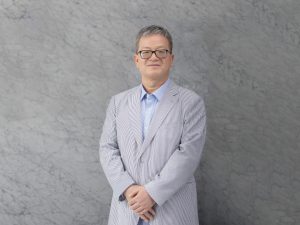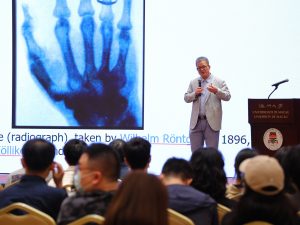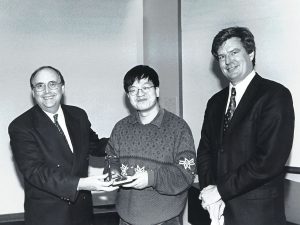‘Like literary creation, mathematical research is an intellectual battle. To find a solution, I can spend an entire day alone, with a blank sheet of paper and a pen.’ With these words, Prof Gui Changfeng shares his daily routine in the pursuit of mathematical research results.
Prof Gui is chair professor and head of the Department of Mathematics in the Faculty of Science and Technology at the University of Macau (UM). He is also a University of Macau Development Foundation Professional Fellow of Mathematics. Over the course of his career, he has solved many of the world’s most challenging mathematical problems, including providing an optimal form of the Moser-Trudinger inequality. ‘After countless attempts and painstaking research, I finally made a breakthrough,’ he says.
Hard work does not necessarily pay off right way
When Prof Gui was young, he possessed an unwavering determination and worked tirelessly to make a name for himself in the field of mathematics.
In 1987, he earned a master’s degree from Peking University and began pursuing a doctorate in mathematics at the University of Minnesota in the United States. During this period, his peers challenged him to solve the world-renowned Moser-Trudinger inequality, which was proposed in 1987 by several mathematicians, including Sun-Yung Alice Chang, a member of the United States National Academy of Sciences and a mathematician at Princeton University. ‘I never thought that it would take me more than 30 years to tackle this problem,’ says Prof Gui.
In 2015, he met a like-minded scholar, Amir Moradifam. With a shared passion for mathematics, they developed a new approach for solving the problem. Together they discovered a new geometric inequality, for which they coined the name sphere covering inequality, and ultimately found the best constant in the Moser-Trudinger inequality in 2018. Their research paper titled ‘The Sphere Covering Inequality and Its Applications’ was published in the top mathematics journal Inventiones Mathematicae in the same year.
‘In research, hard work does not necessarily pay off right way. Success can only be achieved through perseverance and unwavering dedication,’ says Prof Gui.
Making a breakthrough in research
According to Prof Gui, mathematics forms the foundation of almost all science and engineering disciplines, and therefore, they are inextricably linked. The mathematician’s mission is to identify the relationships between different fields and conduct interdisciplinary studies that will promote technological advancements.
Prof Gui further explains that to solve the partial differential equation in the Moser-Trudinger inequality, researchers have to use spatial concepts to understand the involved independent variables, an unknown function dependent on those variables, as and partial derivatives of the unknown function with respect to the independent variables. His breakthrough involves incorporating geometric concepts to discover a new inequality and calculating the sum of areas of two related regions of a sphere. ‘In simpler terms, if we stretched a rubber disc to two different regions on a sphere with the same stretching rate on the boundary, then the covered areas would be more than the area of the sphere,’ he adds.
Another of Prof Gui’s research interests lies in digital image processing. He notes that mathematical methods can be used for image enhancement and denoising, image deblurring, image segmentation, and image restoration, which is beneficial for optimising medical image processing, such as X-rays, magnetic resonance imaging (MRI), computed tomography scans (CT scans), and ultrasounds. Indeed, conformal transformation, the geometric tool he used in his research on the Moser-Trudinger inequality, could also be used for image analysis due to its preservation of subtle image structure. It may even be applied to AI facial recognition systems.
‘To explore an uncharted field, one must rely on bold imagination,’ says Prof Gui, admitting that when he and his colleagues studied the Moser-Trudinger inequality, they did not anticipate they would have to use a geometric approach. It was only later that they realised that there was a missing link, which led them to the idea of sphere coverage inequality. ‘When we are at the forefront of academic research, there are no previous studies for our reference, so we have to follow our intuition as researchers to find a direction,’ he adds.
A letter from Stephen Hawking’s student
Whenever Prof Gui encountered difficulties studying the Moser-Trudinger inequality, he temporarily shifted his focus to other mathematical research.
Over the years, he has successfully solved numerous mathematical problems and achieved significant results in different fields. Among them, he is particularly proud of his breakthrough in the study of the ‘Gibbons’ conjecture’ in 1998, which paved new paths for the study of global symmetry in non-linear partial differential equations. It also caught the attention of Prof Gary Gibbons at the University of Cambridge, who proposed Gibbons’ conjecture, and he wrote to Prof Gui to acknowledge his accomplishment.
Prof Gibbons was a student of Stephen Hawking, and together, they studied black holes and quantum mechanics. ‘In the letter, Gary Gibbons thanked me for continuing his research and using mathematics to explain the mysteries of the universe. It is incredibly inspiring for me. Whenever I encounter difficulties in mathematical research, I think of that letter and it rekindles my confidence in research,’ says Prof Gui.
According to Gibbons’ conjecture, the density of the universe is uniform, and planets are as small as dust within the vastness of the universe. Prof Gui explains the relationship from the perspective of physics, stating that if the universe was compressed into a single object, it would be like a solid piece of wood, with uniform density in all directions. ‘We use mathematics to prove this concept and develop a mathematical model based on three-dimensional space to uncover the concept of the structure of the universe,’ he adds.
The journey to becoming a mathematician
Prof Gui was born in Qiyang, Hunan province, where there was little entertainment available. ‘My mother was a math teacher who instilled in me a passion for mathematics at a young age. Solving puzzles like the “chicken and rabbits in a cage” problem was part of my happy childhood,’ he recalls.
As he grew older, Gui realised the importance of college education, the dependence of science and engineering disciplines on mathematics, and the role of mathematics in technological development. He aspired to become a mathematician and studied very hard. In 1980, he was admitted to the Department of Mathematics at Peking University, a milestone on his journey to becoming a mathematician.
After spending many years abroad, in 2005, Prof Gui began to return to China each year to work with the Department of Mathematics at Hunan University, which is located in his hometown. He focused on cultivating mathematical talent and collaborating with scholars in mainland China in mathematics and image processing research. During this period, he achieved notable results, some of which were published at IEEE International Conferences and applied in engineering.
Whenever he mentions his hometown Qiyang (located north of Yongzhou), Prof Gui cannot hide his excitement. ‘The Tang dynasty literary figure Liu Zongyuan was a visitor to my hometown,’ he says, and then recites Liu Zongyuan’s prose ‘The Snake-Catcher’, which was written during his exile to Yongzhou. Prof Gui then acknowledges his favourite scenery in Qiyang, the Wuxi Stele Forest. ‘The majestic stone carvings there, especially Yan Zhenqing’s calligraphy masterpiece “Eulogy on the Restoration of the Great Tang Dynasty”, are very impressive.’
Growing up in a natural environment, Gui developed a rich imagination and a discerning eye for aesthetics . He says mathematics conveys information similar to the way literature describes the world. ‘Both literature and mathematics require boundless imagination to identify the crux of the problem through logical deductions,’ he says.
Experiencing the first highlight in research
After completing his doctoral degree in the United States in 1991, Gui was appointed as a lecturer at the Courant Institute of Mathematical Sciences of New York University, marking the beginning of his research career.
Every researcher encounters obstacles, and Gui was no exception. ‘As researchers, we are racing against time to find the answers one step ahead of others,’ he notes, ‘I have also had my share of down moments, often working late into the night, and staying awake in the middle of the night thinking about the problem. Sometimes I went to bed with great joy but woke up to find out that I was wrong. But on second thought, pressure can be a driving force. Life is about aiming high, and even if you do not achieve success in the end, you still gain a lot in the process.’
In 1995, Gui experienced the first highlight in his research career.At that time, he was a postdoctoral researcher at McMaster University in Canada. After countless days and nights of calculations, he successfully enriched the critical point theory in the calculus of variations, proving the existence of multi-peak solutions with higher energy on boundaries in general situations, as well as their asymptotic properties. His research results overturned conventional thinking in the study of multi-peak solutions and immediately sparked a wave of research in the field.
Joining UM to develop the Department of Mathematics
Prof Gui has taught at several universities in Canada, the United States, and mainland China, and he has accumulated extensive experience in teaching and research. In January 2023, he joined UM as the head of the Department of Mathematics to develop the department.
He believes that innovation and development in mathematical research have a significant impact on the advancement of other disciplines. ‘Higher education institutions around the world are strengthening the cultivation of interdisciplinary talent in mathematics and expanding into new research areas. Therefore, we must also keep pace with the times, enhance our students’ logical and abstract thinking skills, and improve their mathematical literacy to adapt to new developments and emerging applications of mathematics,’ he says.
In light of the global development of artificial intelligence and computer science, Prof Gui expects that rapid technological advancements will help solve difficult mathematical problems and believes that breaking down disciplinary barriers, particularly in applied mathematics, is crucial for the future development of mathematics. ‘By leveraging UM’s interdisciplinary platform, we can promote the integration of mathematics with other disciplines, so that students and teachers can explore the unknown world of mathematics with a broader and deeper vision,’ he adds.
Introduction to Prof Gui Changfeng:
Prof Gui Changfeng is chair professor and head of the Department of Mathematics in the Faculty of Science and Technology at the University of Macau. He is also a University of Macau Development Foundation Professional Fellow of Mathematics. Prof Gui has dedicated over 30 years to mathematics teaching and research , and has worked at several universities in Canada, the United States, and mainland China. He is known for his research on non-linear partial differential equations, image analysis and processing, and for solving many of the world’s most challenging mathematical problems. He has published over 100 papers in top international journals, including Annals of Mathematics, Inventiones Mathematicae, and Communications on Pure and Applied Mathematics.
Prof Gui has received numerous awards, including the Research Achievement Award of the Pacific Institute for the Mathematical Sciences, the André Aisenstadt Prize in Mathematics from the Centre de Recherches Mathématiques, the Best Paper Award from the IEEE Signal Processing Society, and the Overseas Cooperation Fund of the National Natural Science Foundation of China. He is a fellow of the American Mathematical Society, and the Dan Parman Endowed Distinguished Chair in Applied Mathematics at the University of Texas at San Antonio. He was appointed as a Chang Jiang Scholar Chair Professor by the Ministry of Education in 2006.
Text: Kelvin U, Trainee UM Reporter Huo Shiying
Photo: Jack Ho, with some provided by the interviewee
English Translation: Winky Kuan
Source: My UM ISSUE 124



